I’ve renovated 4 kitchens – these are the 7 questions I wish I'd asked before I started my kitchen renovation
Overwhelmed by your upcoming kitchen reno? Answering these 7 questions will help you get your ducks in a row…
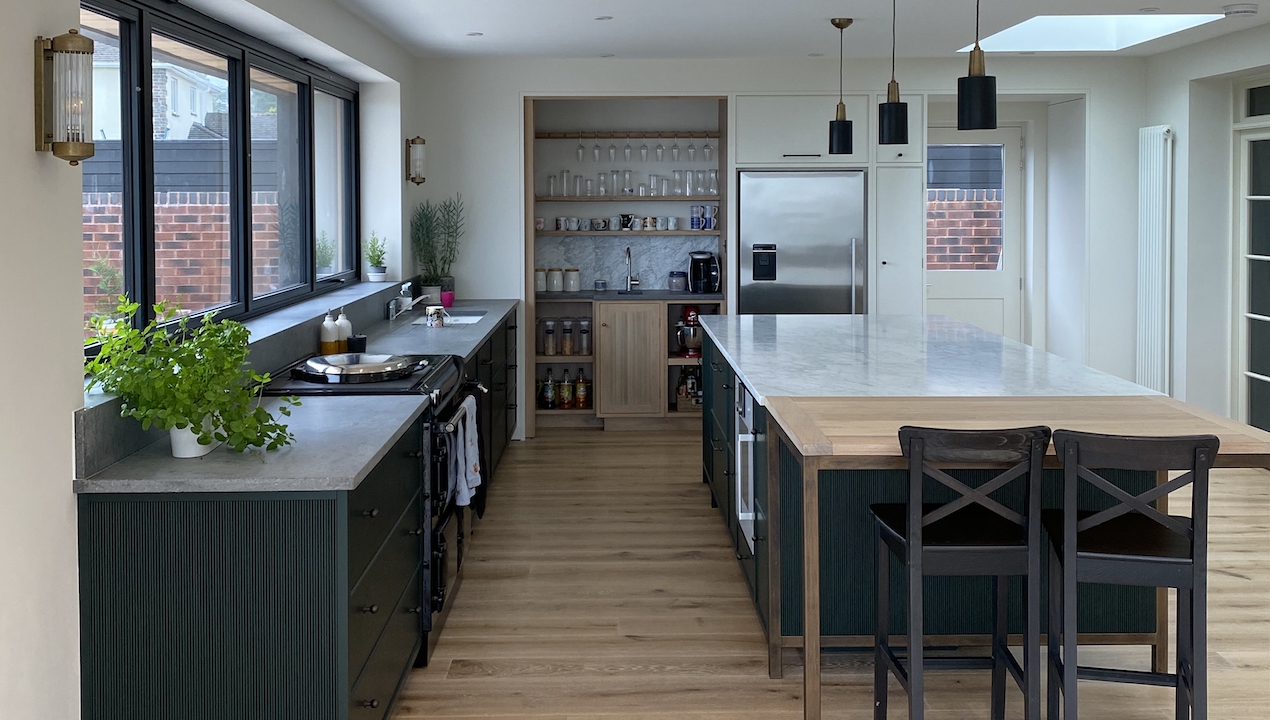

If there’s one stage of renovating a kitchen that cannot be rushed, it’s the planning process – as I have learnt, the hard way. Only fools rush in and, trust me, impatience will always result in disaster. Or at least some minor annoyance that drives you insane on the regs, like a too-small bin that requires endless emptying or sockets in the wrong place.
I’ve now renovated four kitchens with lots of hard, and often expensive, lessons learnt along the way. Kitchens and bathrooms are my specialist subject as an interiors journalist, having begun my career working for the kitchen and bathroom trade press and fallen (in quite a nerdy way) for the technical side of planning these complex spaces. Oh, and my husband designs and makes kitchens for a living, too, so I really don’t have an excuse for being so lax with this vital planning stage over the years.
While it’s tempting to skip to the fun part of choosing colours and shopping for cute light fittings when designing a kitchen, asking the right questions early on can save so much time, money and a whole world of stress. Now I will begin any new kitchen project (of which I am sure there will be more, just don’t tell my husband) by asking myself these seven questions and fleshing out the answers.
1. What’s my actual budget?
How much you’ve got to spend on your new kitchen versus how much it will actually cost can be wildly different figures. Unless you have rich (and extremely benevolent) relatives or a Nigerian Prince on standby to bail you out, the very first question should be, how much do I have to spend? Or rather, how much am I prepared to spend? Do make sure the figure tallies with your partner’s thinking too, if applicable, to avoid the added expense and inconvenience of divorce…
How to get it right: Start by defining your available budget (by looking at your savings account), then subtract a buffer of 10-20% for unexpected expenses (there WILL be unforeseen costs), which will give you the total amount you have clear to spend. For example, if you have £15,000 in the pot, your actual kitchen budget is £12,000-£13,500.
The known costs of renovating a kitchen – cabinets, appliances, worktops, rewiring, plumbing etc – are fairly easy to find out, it’s those sneaky hidden costs that can unbalance the most meticulous of spreadsheets. Here are just a few that have badgered our budget over the years:
- Extra insurance (while the work is ongoing).
- Building regulation fees and inspection costs (even if the work comes under Permitted Development).
- Structural issues (like the ceiling unexpectedly caving in).
- Material price hikes (get any quotes agreed for at least 30 days).
- Delivery charges (they can really add up).
- Eating out for three weeks (when the ceiling caved in).
- A new boiler (if your current one isn’t up to the job or doesn’t comply with modern standards).
Tip: Track spending to help prevent things getting out of hand. I use Plum, which links savings and credit cards so you can easily see exactly where everything is going and where you stand each month.
Get the Ideal Home Newsletter
Sign up to our newsletter for style and decor inspiration, house makeovers, project advice and more.
2. How do I really use my kitchen?
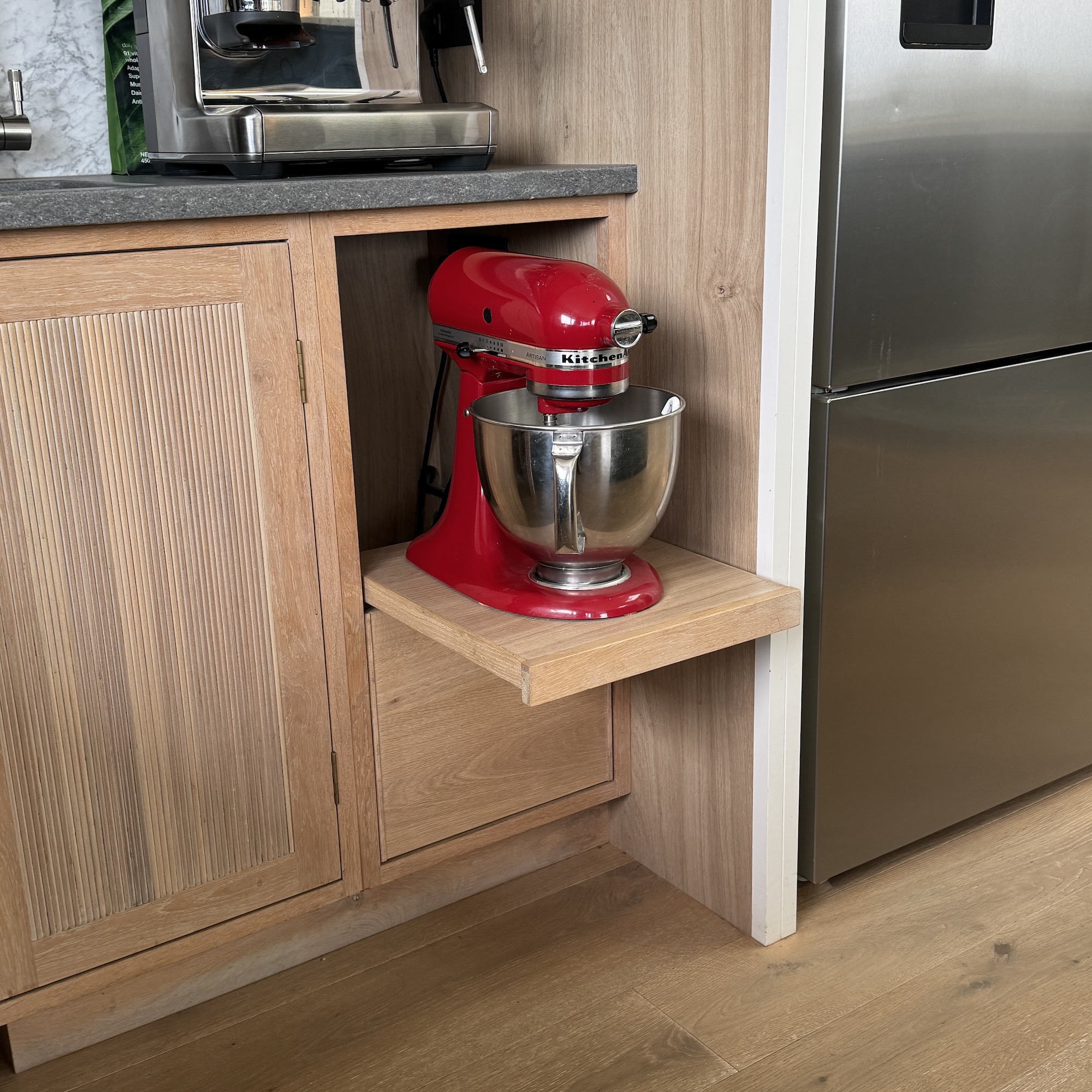
A pull-out stand means the KitchenAid is always ready to go.
Again, this is one where only brutal honesty works. You might be imagining wafting around your beautiful new kitchen baking cupcakes and spritzing surfaces with vegan-friendly cleaners made from Fir, Bergamot and the tears from newborn unicorns. If, in reality, you mostly make pesto pasta in six-minutes flat and clean every seventh Tuesday, such dreamy aspirations are wholly unhelpful.
How to get it right: Focus on how you’ll be using your kitchen the majority of the time, not just when you have guests. If you do entertain regularly, go ahead and get three ovens, but if you only have guests on Christmas day, consider using a gas barbecue with a lid to cook the turkey (honestly, it works a dream).
Functionality should be at the forefront of your mind; do you cook together and therefore need lots of prep space and maybe an extra prep sink? What do you eat for breakfast? What else do you want to do in there – dine, watch TV, drink prosecco, homework, work? I do a lot of baking but didn’t want my KitchenAid on the worktop permanently, so we have a pull-out shelf that lets me leave it plugged in but tucked out of the way.
Tip: Think about your lifestyle when planning storage. For example, a dedicated drinks station or bar can be handy for caffeine addicts/wine buffs and a charging cupboard or drawer will help keep worktops clear of trailing cables if you’re a multi-device family.
3. What annoys me most about my current kitchen?
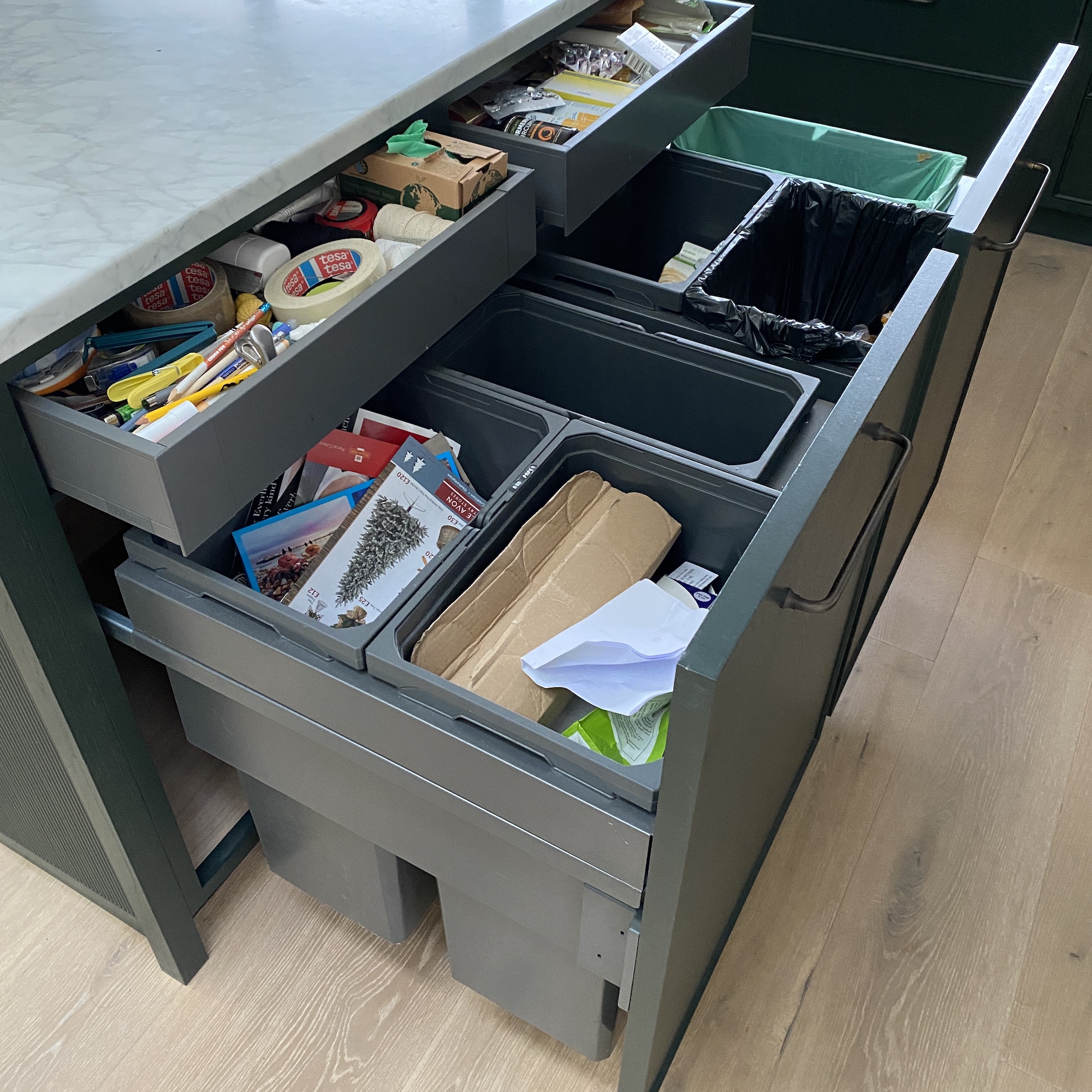
Six bins and two 'odds & sods' drawers!
Does the tap get in the way when opening the window, or do the bar stools face a blank wall? Also think back to grievances in past kitchens – like the kitchen without recessed kickboards that I stubbed my toes on every day – quiz friends and family for their top bug-bears, too. Thinking about this question very carefully has been one of the main ways I’ve slowly improved my kitchen set-up (to near perfection) over the years.
How to get it right: As well as thinking about issues with the existing kitchen (assuming I’ve lived with it for a while, which I usually do due to lack of immediate funds/near bankruptcy after moving home), I also try to think hypothetically as I plan a new kitchen. For example, if I put the dishwasher there, will it be hard to get past when the drop-down door is open? Will putting the bin under the sink drive me bonkers when someone wants to toss a tissue and I am washing pans (yes, yes it will)? And so on.
We’ve dedicated about a quarter of the storage space in our massive island unit to waste and recycling but now we only have to empty the bins once a week – totally worth it!
Common kitchen annoyances, in no particular order, are:
- Not enough storage where it’s needed
- Not enough storage at all
- Narrow walkways (aim for 90cm minimum)
- Insufficient worktop space
- Traffic through the main working area
- Ineffective and/or noisy extraction
- Not enough rubbish and recycling bins
- Badly positioned or insufficient lighting
- Poorly positioned sockets and switches
- Shelves you can't reach
- Fridge doors that open the wrong way!
4. How much cleaning am I prepared to do?
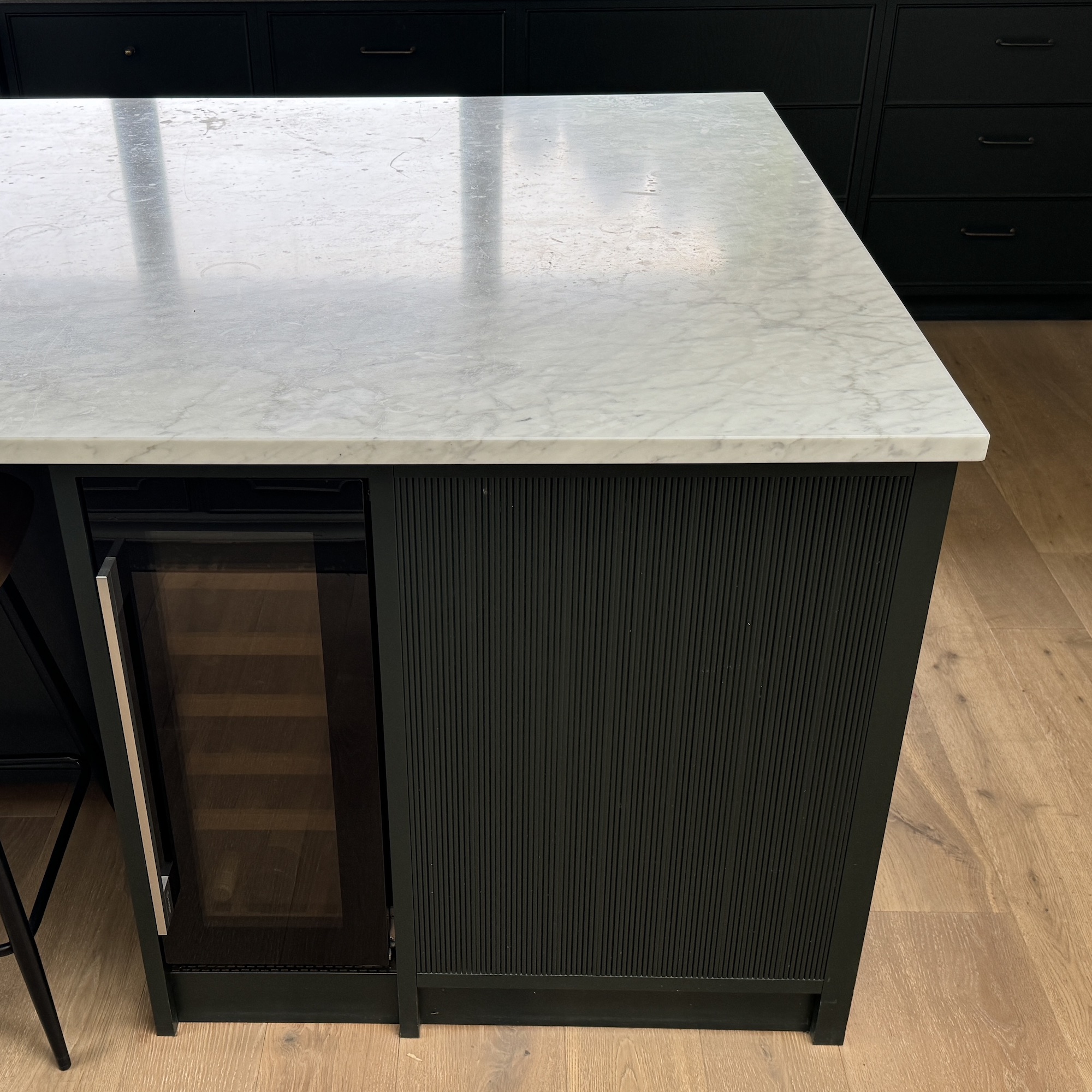
Our marble worktops desperately need resurfacing.
TDecluttering influencers aside, not many people actively enjoy cleaning, but do you properly loathe it? And are you prepared to make sacrifices with your materials and finishes in order to reduce the amount of time spent in Marigolds? Or will you happily give up some scrolling time to buff Brasso into those gorgeous polished brass fittings?
How to get it right: I love my kitchen clean and clutter-free but am also very skilled at procrastinating when it comes to cleaning and maintaining it. The only serious mistake I made with my current kitchen is choosing natural marble for the island worktop, which I thought I’d get sanded and resealed annually (as recommended) but we’re four years in and it still hasn’t been done once. The dust, and expense, puts me off. I would love to change it to something much lower maintenance, ideally a manmade surface like Dekton or Caesarstone’s Porcelain.
Don’t be me, instead find out how much manual labour and maintenance is involved for all the main materials you have in your sights – cabinet finish, worktops, taps, handles, flooring and splashbacks, and think very long and hard about whether you will do it. Or just sigh with disappointment every single day.
Tip: On stainless steel surfaces, like appliances and sinks, look for anti-fingerprint coatings and/or brushed finishes. Stubborn smudges can be removed with window cleaner and a microfibre polishing cloth.
5. Where do I really need lighting?
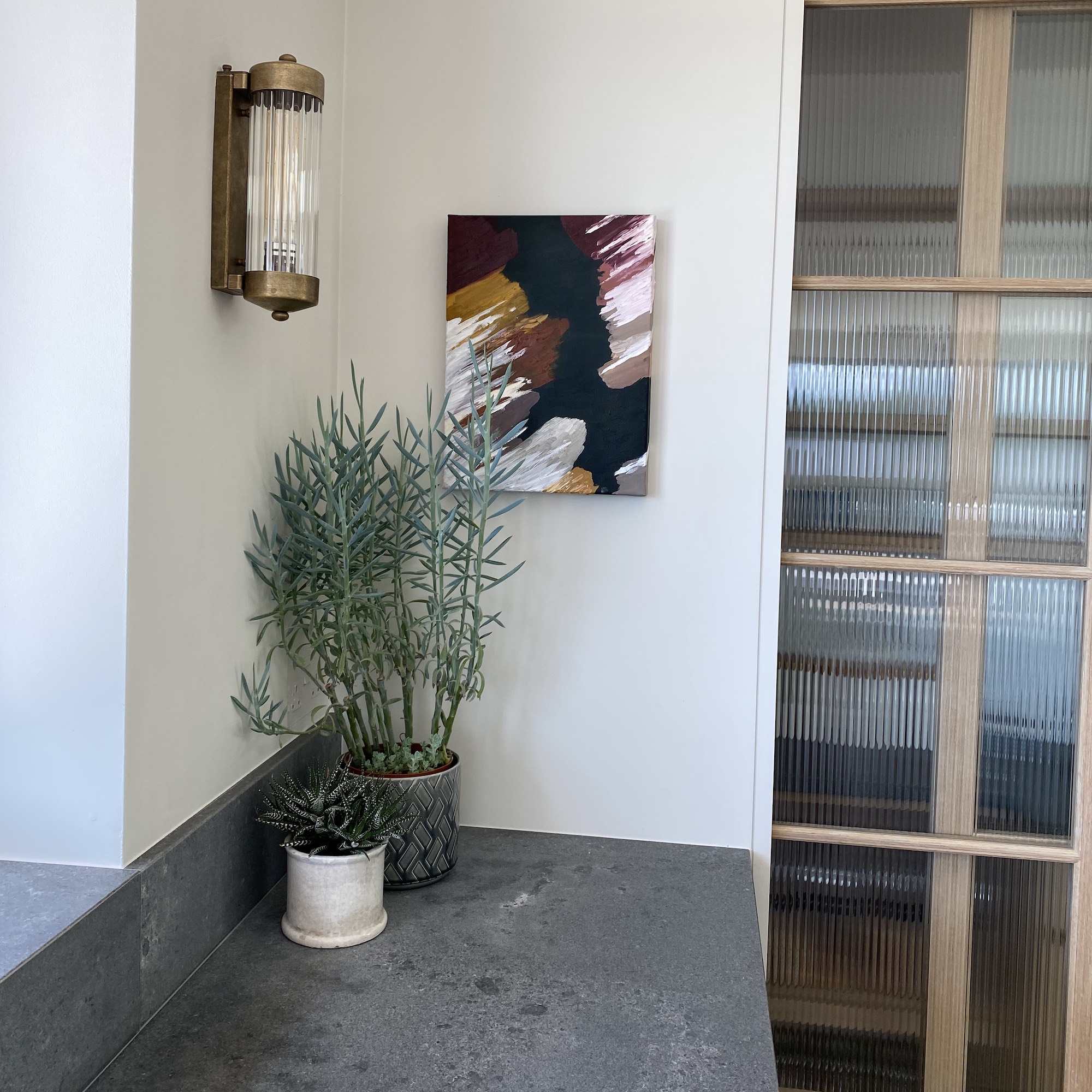
A wall light brightens this corner by night.
Poor kitchen lighting – especially around the hob, sink and main prep area – can be intensely irritating. You probably won’t cut a finger off, but you will get frustrated if you’re constantly working in your own shadow. I’ve never, ever had a kitchen with too many lights, especially now I fit dimmer controls so every fitting can be dialled up or down or off, but I’ve had plenty with not enough light where it’s needed. And it sucked.
How to get it right: Always start by covering off the main task areas and make sure your electrician understands exactly where those lights need to be placed – use a Sharpie to X-mark the spot if necessary, and do not let him/her arrange ceiling downlights in a neat grid for the sake of symmetry (which seems to be the default). Then add some more decorative lighting like island pendants and wall lights on a separate switch. I’m obsessed with our Cheltenham wall lights by Jim Lawrence.
You can also wang some hidden LEDs under shelving, wall cabinets and the kickboards if you want to be ultra fancy and create a relaxed, low-level atmosphere in the evenings. But don’t stress too much, as you can always introduce a couple of rechargeable lamps at a later date if you feel like a corner or two needs brightening – it’s those task lights you really need to prioritise.
Tip: Go for warm white bulbs at all times. Bright white bulbs tend to give surfaces a bluish tinge – chilly – and can also make your complexion appear slightly sickly!
6. Do I really love that look/colour/pattern?
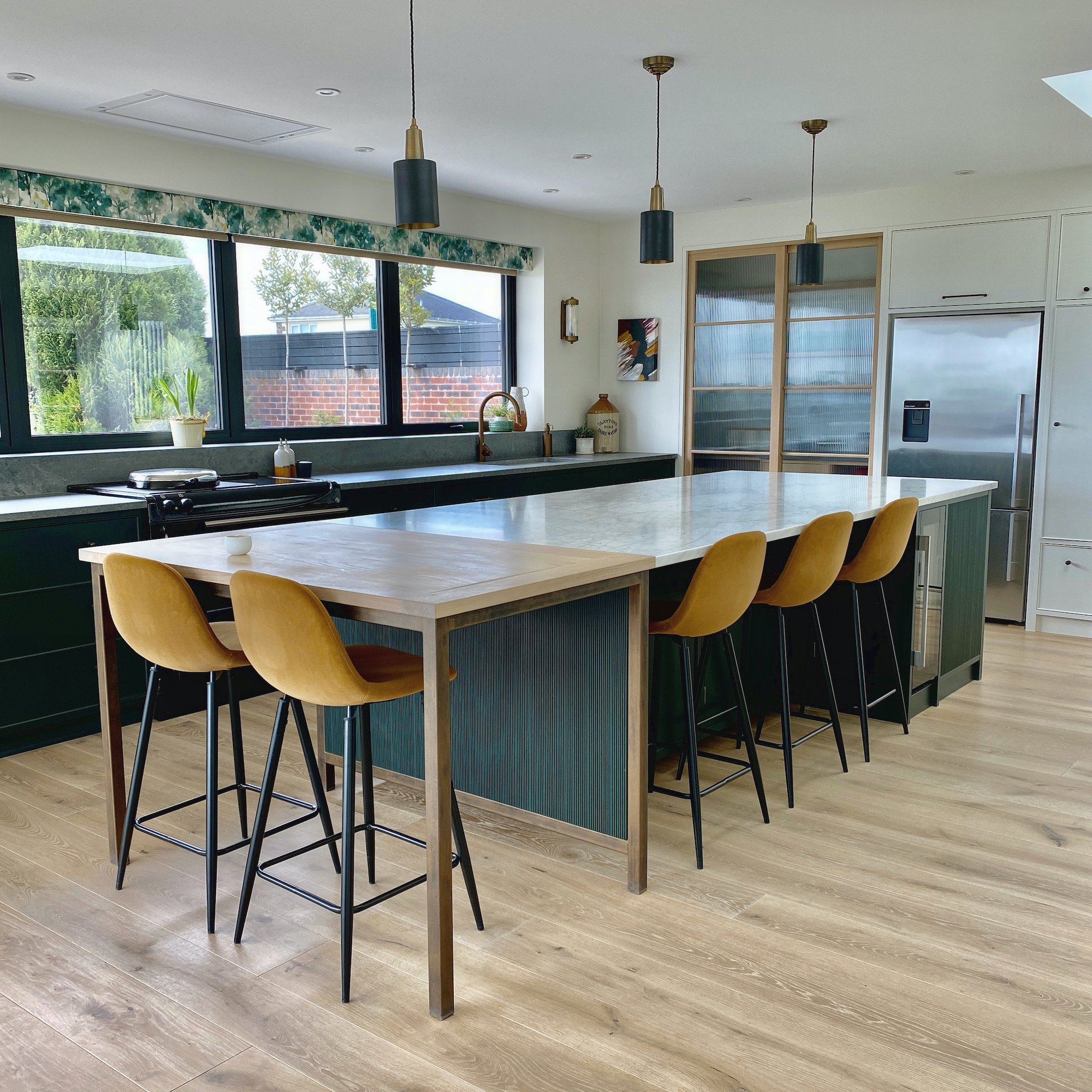
I'll never tire of this Obsidian Green by Little Greene.
Any idiot knows that the design choices you make in a kitchen need to stand the test of time. But I also now know how easy it is to fall in love with a trend and convince myself I love it, when really I just love the idea of it or how it looks on my Socials. Admittedly there’s also a strong chance I’m trying to impress my mates/Instagram followers.
How to get it right: This one is quite tricky, because many trends really are desirable and maybe you are THAT edgy, cool, brave. In which case, ignore this question. But if, like me, you can be quite fickle you need to be strong and resist anything too mad. Assuming you don’t want to run the risk of having to re-paint/re-upholster/re-tile in 12 months’ time. After making several dodgy design choices over the years, for our most recent kitchen I went down a more timeless route with slim-frame Shaker cabinets, painted in my all-time favourite colour, green.
Tip: You may have heard this one before but one of the best pieces of advice I’ve ever followed regarding trends is to look for inspo inside your wardrobe. Mine is filled with every shade of green…plus a bit of mustard yellow, white and black (and enough stripy tops to get me to my grave). I’m pretty confident my green and white kitchen will make me happy for many years to come.
7. Who is going to help me?
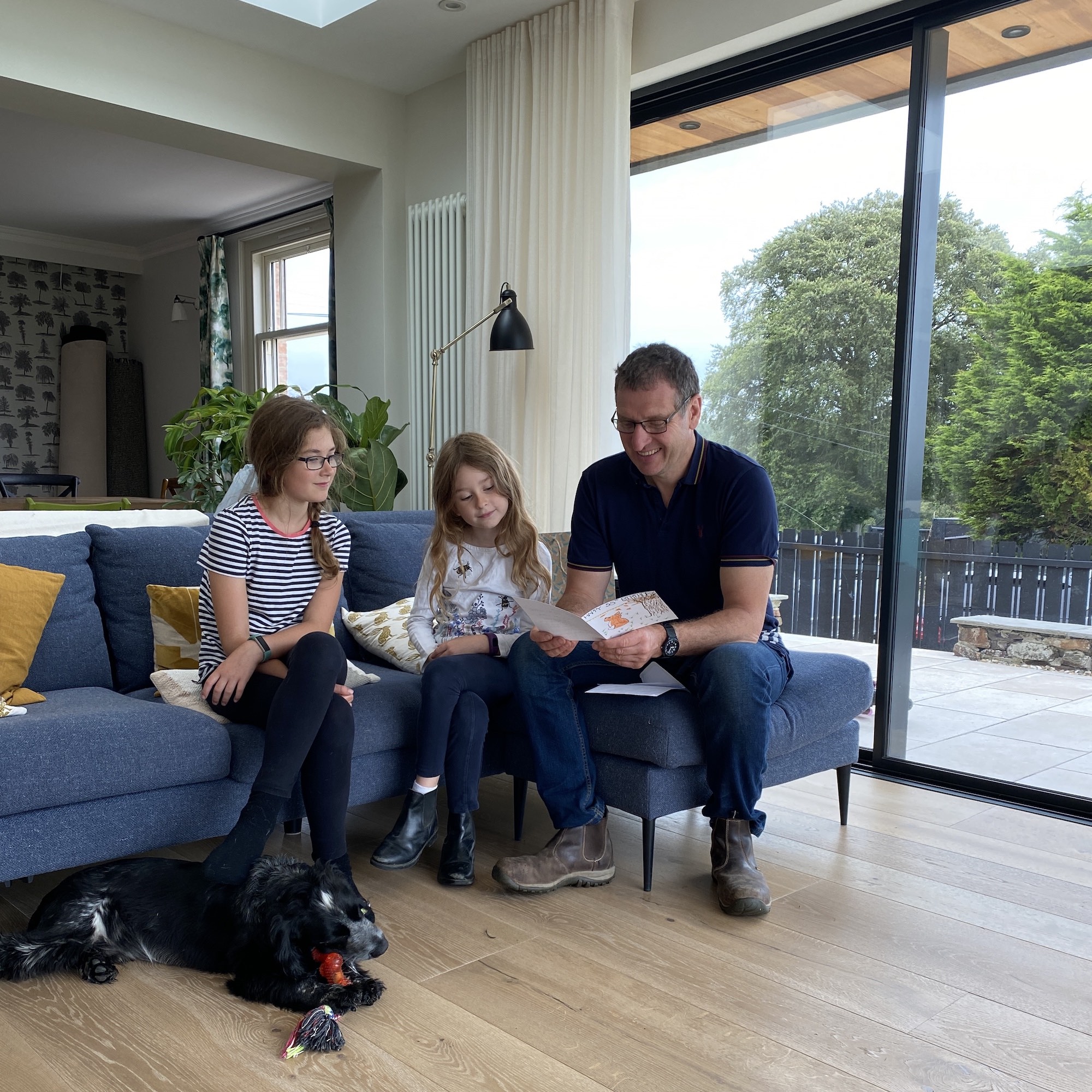
Obviously my cabinetmaker husband, Nick, was heavily involved (our kids and dog, not so much)!
Even in my most recent kitchen renovation I failed to appreciate the importance of getting the right team onboard, hiring trades on the basis that they were available, rather than doing my homework and getting (and cross-checking) references. In my defence, it was during the dark days of Covid and getting any trades to darken my door at all was a miracle.
My builder turned out to be a total rock star, and the electrician I already knew and loved, but I found a plumber via a local Facebook group and he turned out to be shockingly bad at his job. And quite possibly on drugs most days. He ran off before the job was finished (after he’d taken most of his money of course) and did something to the water supply that meant I could spit with more pressure than we got from the kitchen taps.
How to get it right: Work out what sort of skilled services you need and then do your research and find the best person in your area for each job. Use sites like TrustATrader and Checkatrade to find local specialists but ask to speak to past customers about their experiences before you commit. Better yet, get personal recommendations from people you know and trust who have used them for a similar project.
For a straightforward kitchen renovation, you’ll need: a plumber, electrician, builder and/or kitchen installer, and possibly a tiler and plasterer. You may also need worktop fabricators and a kitchen designer. Our kitchen projects have always included an extension, which means we’ve also needed glazing specialists, an architect and a structural surveyor.
Tip: When you meet, ask as many questions as possible and tap into their knowledge and experience for ideas and solutions to any challenges you’re facing. Also make sure you like them. They’ll be in your home at all hours of the day and life will be easier if you get on.
Linda’s kitchen renovation questionnaire
- What is the budget?
- How will I use the space?
- What problems need solving?
- How much cleaning will I do?
- What are my lighting needs?
- What overall look am I going for?
- Who will do the work?
By answering these seven questions, you’ll be ready to move forward with your kitchen renovation with confidence. What are you waiting for?

Linda Clayton is a professionally trained journalist, and has specialised in product design, interiors and fitness for more than two decades. Linda has written for a wide range of publications, from the Daily Telegraph and Guardian to Homes & Gardens and Livingetc. She has been freelancing for Ideal Home Magazine since 2008, covering design trends, home makeovers, product reviews and much more.
-
 Wisteria umbrellas are this spring's breakout garden trend – not only are they perfect for small spaces, but they're easier to maintain, too
Wisteria umbrellas are this spring's breakout garden trend – not only are they perfect for small spaces, but they're easier to maintain, tooI spoke to the National Trust to find out why
By Sophie King
-
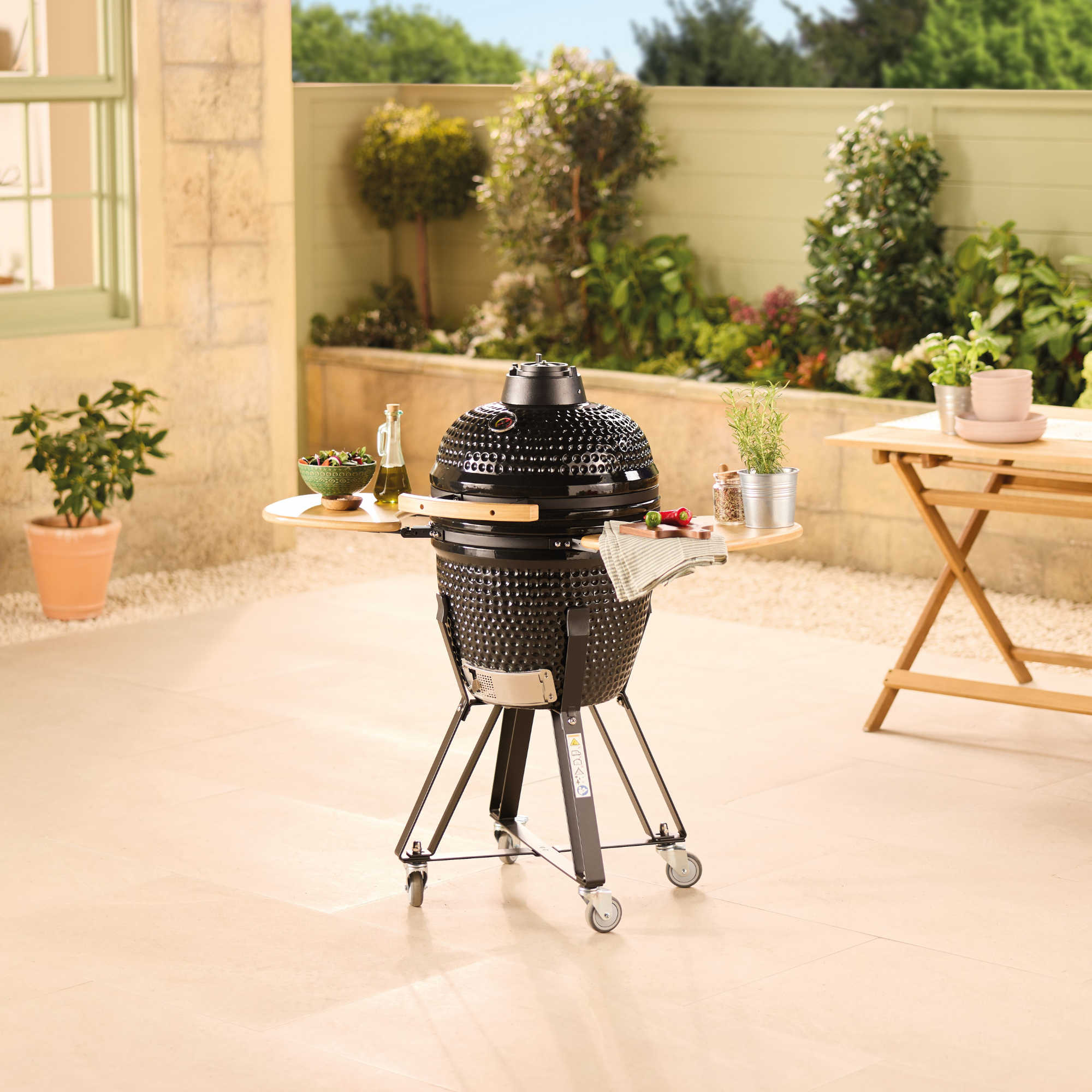 Aldi’s cult Kamado BBQ is returning to stores and it's £100 cheaper than last time
Aldi’s cult Kamado BBQ is returning to stores and it's £100 cheaper than last timeThis budget BBQ is only a fraction of the price of this celebrity favourite
By Kezia Reynolds
-
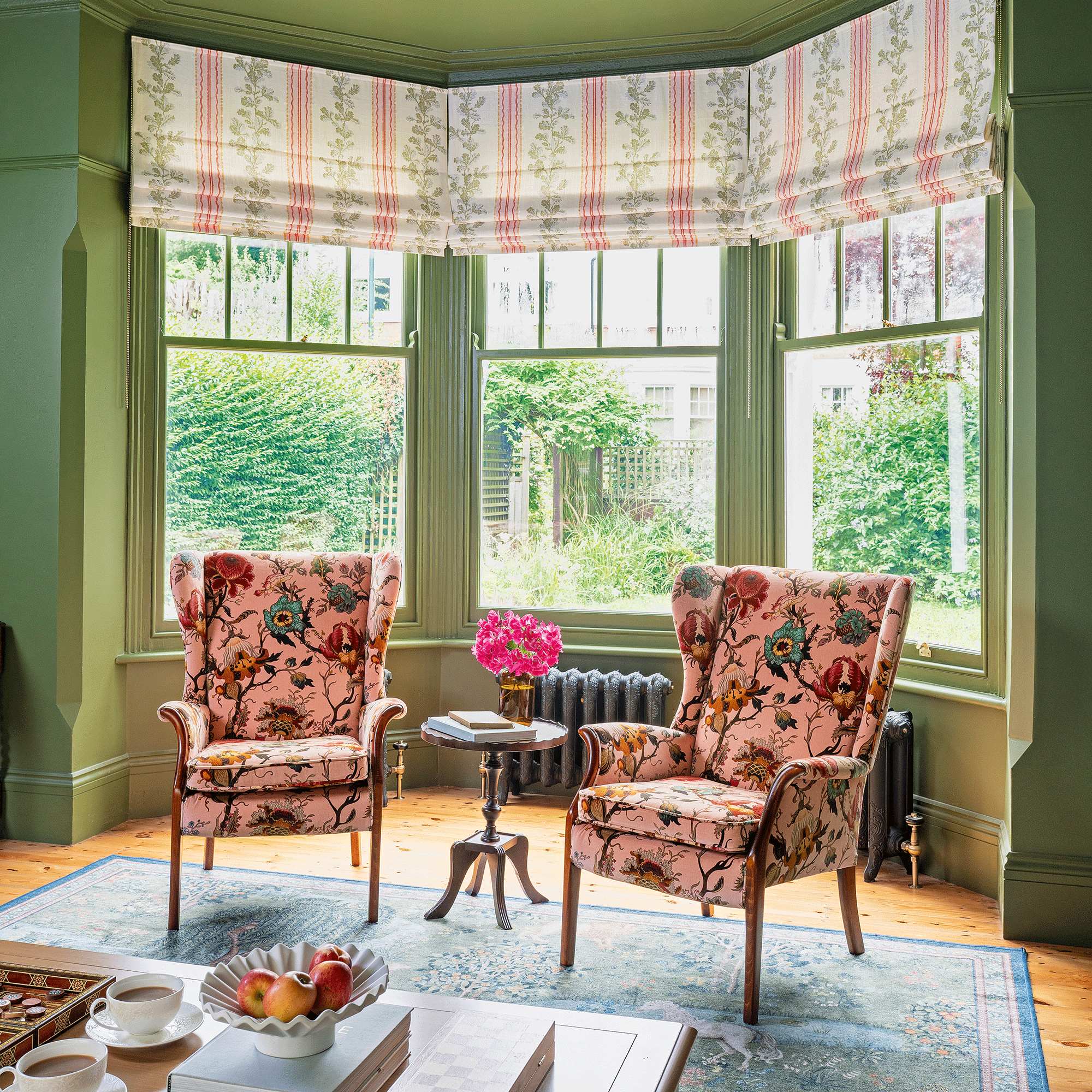 A strict colour palette and vintage finds have turned this semi-detached Edwardian house into an elegant family home
A strict colour palette and vintage finds have turned this semi-detached Edwardian house into an elegant family homeSticking to a three-colour palette of green, pink and yellow and mixing in plenty of vintage furniture and art has created an authentic period feel
By Stephanie Smith